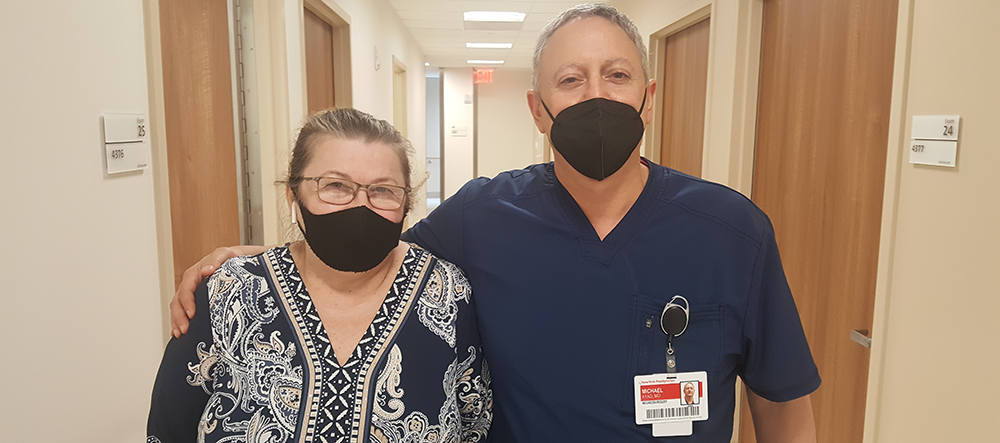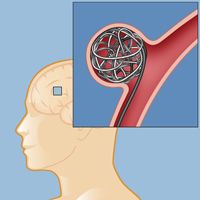
Barbara Hirsch, 62, of Brooklyn, New York, spends long days as a housekeeper doing demanding and strenuous work. During her time off she enjoys nothing more than being at home, relaxing and spending time with her husband and daughter. Recently, however, there was something standing in the way of both work and leisure: a serious bout of headaches. These weren’t typical headaches, either. “It felt like someone was drilling in my head,” Barbara recalls. “I wasn’t getting help from my current doctor, so I asked him to refer me to a specialist.” Thankfully, that path led her to Dr. Michael Ayad and the team at NewYork-Presbyterian Brooklyn Methodist — and freedom from her terrible headaches.
When Barbara went to see the neurologist, she expected to be sent for tests. But she was not expecting the results of the MRI and she was stunned by the diagnosis. “When I heard the specialist say ‘aneurysm,’ I didn’t react,” she says. “I thought I was going to die.”
“Barbara’s first thoughts were the same as many other patients I’ve treated over the course of my career,” says Dr. Ayad. “When people hear the word aneurysm, they immediately think of a rupture. They think it’s a death sentence. But an aneurysm starts with a weak spot in an artery. As blood flows past that weak point, it puts pressure on the arterial wall and swells out into a little sac. If the bulge ruptures, that bleed is what can be life-threatening. Depending on where the aneurysm is, and how big it is, sometimes it can be left alone and monitored with regular doctor visits. If we do see a risk of rupture, we can perform surgery to repair it.”
It took a little time for the diagnosis to sink in. “It hit me when I got home,” Barbara recalls. ”I was on the phone with my daughter-in-law, and I just broke down. I had two relatives recently die from an aneurysm. I thought it was instant death. From what I thought, no one survives it. You don’t see it. And if you don’t see it, you don’t go to the doctor. You don’t do tests, and you’re dead. But I was alive. And the specialist referred me to Dr. Ayad, so I put my trust in him.”

Dr. Ayad‘s methodical nature assured Barbara that her trust was well placed. He told her that her aneurysm was at relatively higher risk for rupture due to its 9 mm diameter and its location; additionally, a very important artery was noted to arise from the base of the aneurysm itself. “I advised Barbara that intervention for the aneurysm is highly recommended,” he says. “I told her that the aneurysm could be repaired either with open surgery or with an endovascular intervention, where we would navigate tiny tools within her arteries up to the aneurysm, starting from the femoral artery in the groin. Due to her other medical conditions, the latter was considered the safer route for treating her aneurysm.”
“Dr. Ayad was very careful. He consulted with my other doctors to make sure I would be okay with this surgery,” recalls Barbara. “I appreciated that he always came in person. He was never too busy for me. Never sent anyone else. He always took his time. Whatever I asked, whatever I wanted to know, he answered every one of my questions. I believed in him not 100, but 150 percent!"
Barbara was relieved when Dr. Ayad told her that the procedure he recommended was minimally invasive. “We’ve come a long way in surgery for aneurysms,” he says. ”Not that many years ago, Barbara’s options would have been more limited, and more complicated. Now, with endovascular techniques, we are able to repair the aneurysm without drilling into the skull. In Barbara’s case, platinum coils were placed within the aneurysm, and a tiny balloon was used to ensure that the coils did not bulge into the arteries themselves. And because the incision is very small, patients experience a quicker recovery, often with fewer complications.”
That was precisely the case for Barbara. “My recovery was surprisingly fast. It was really quick, with just one night in the hospital,” she recalls. “One week later, I was back to work. I wasn’t allowed to pick up any heavy stuff, but I was cleaning. I was back. Some days I still have headaches, but you can’t compare that drilling sensation I had before to what I’m feeling today.”
For a patient getting the same diagnosis she did, Barbara advises finding the right doctor. “I’d send them to Dr. Ayad!” she exclaims. Do the research and find an endovascular specialist, she says. Mostly, she adds, “don’t be scared — because this could save your life.”